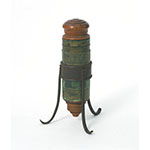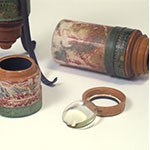The compound microscope, made of cardboard, leather and wood, is inserted in an iron support with three curved legs. The outer tube is covered in vellum green decorated with gold tooling. There are three lenses (an objective, a field lens, and an eyepiece), all double-convex. The objective measures 11 mm in diameter and has a thickness of 3.5 mm. The glass is clear with few imperfections; the edge is ground and there are some fine chips. The field lens (diameter 30 mm, thickness 4.7 mm) is in a cell that pushes into the bottom of the inner tube. The glass is amber-green, with air bubbles, and has a ground edge that is chipped; the eyepiece, with an aperture of 24 mm, also has some bubbles; it is protected by a wooden cap that screws onto the mount. This very important instrument was said to have been built by Galileo, but is now more plausibly attributed to Giuseppe Campani. Johannes Faber, fellow of the Accademia dei Lincei, gave the name "microscope" (microscopio) to Galileo's "small eyeglass" (occhialino) in 1625.











